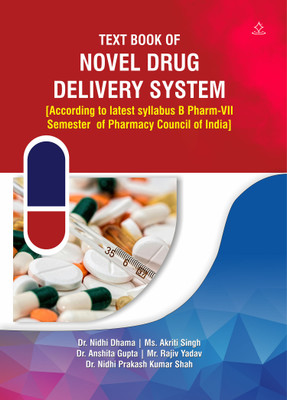TEXT BOOK OF NOVEL DRUG DELIVERY SYSTEM - According to latest syllabus B Pharm-VII Semester of Pharmacy Council of India(Paperback, Dr. Nidhi Dhama, Ms. Akriti Singh, Dr. Anshita Gupta, Mr. Rajiv Yadav, Dr. Nidhi Prakashkumar Shah)
Quick Overview
Product Price Comparison
The Textbook of Novel Drug Delivery Systems is a comprehensive resource that provides in-depth knowledge on the latest advancements and methodologies in drug delivery technologies. Beginning with Controlled Drug Delivery Systems, the book covers essential concepts such as definitions, rationale, advantages, disadvantages, and drug selection criteria. It explores various formulation approaches including diffusion, dissolution, and ion exchange mechanisms, alongside the physicochemical and biological properties necessary for controlled release. The section on Polymers introduces their types, properties, and vital applications in controlled release systems. Microencapsulation is thoroughly discussed, from its definition and types (microspheres, microcapsules, microparticles) to the methods and diverse applications in the pharmaceutical field. The book delves into Mucosal Drug Delivery Systems, explaining bioadhesion principles and buccal delivery system considerations, highlighting their permeability and formulation strategies. Implantable Drug Delivery Systems are explored in terms of their potential, limitations, and the role of osmotic pumps and implants. In the Transdermal Drug Delivery Systems chapter, readers learn about skin permeation, influencing factors, enhancers, core components, and formulation techniques. The Gastroretentive Drug Delivery Systems (GRDDS) section addresses systems like floating, high-density, inflatable, and gastroadhesive types, explaining their significance and applications. The Nasopulmonary Drug Delivery System chapter provides valuable insights into nasal and pulmonary routes, covering formulation aspects of inhalers (DPIs and MDIs), sprays, and nebulizers. The Targeted Drug Delivery section introduces advanced carriers like liposomes, niosomes, nanoparticles, and monoclonal antibodies, detailing their roles and therapeutic applications. Ocular Drug Delivery Systems are analyzed with respect to intraocular barriers and modern formulation techniques such as ocuserts. Lastly, Intrauterine Drug Delivery Systems are discussed in terms of their benefits, limitations, device development, and practical applications. This textbook is an essential academic and professional guide for students, researchers, and pharmaceutical technologists aiming to understand and innovate in the evolving field of novel drug delivery systems.

